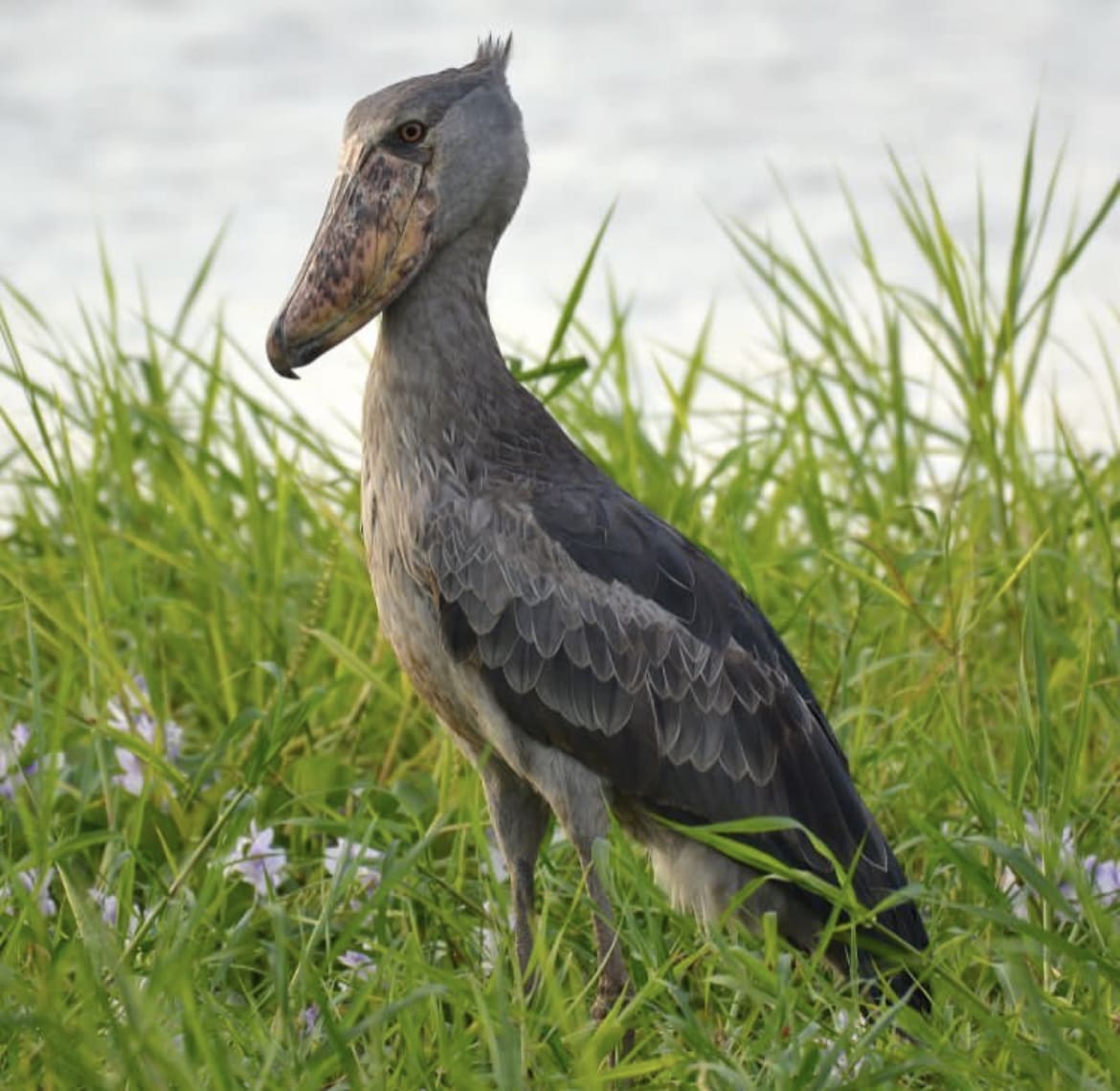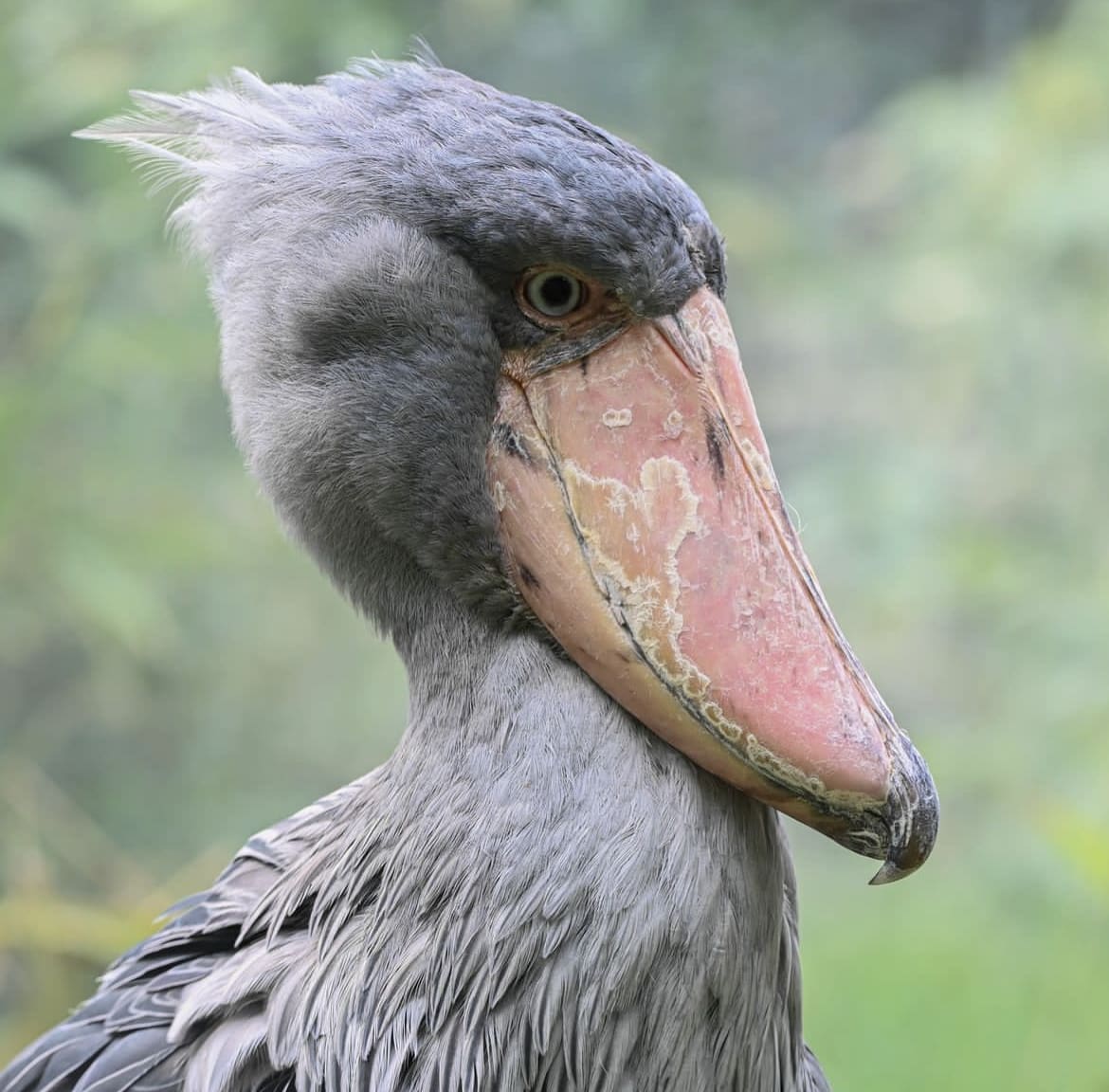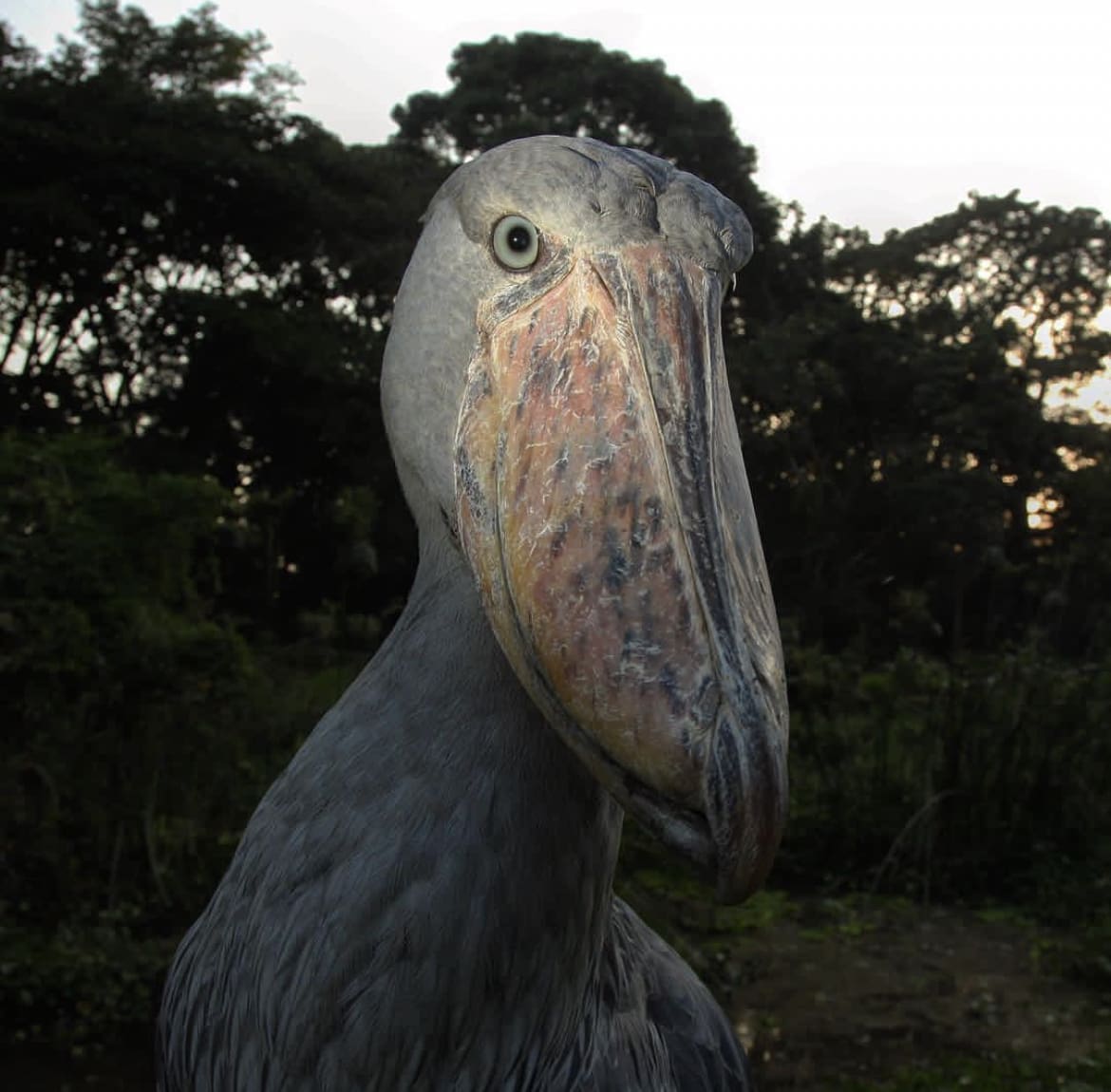In the heart of the wetlands and swamps of Africa stands a remarkable avian sentinel that appears to have stepped out of the pages of prehistoric lore. The shoebill stork (Balaeniceps rex), a majestic and enigmatic creature, is a captivating subject that has captured the imagination of naturalists, researchers, and storytellers alike.
With its towering stature, distinctively massive bill, and haunting gaze, the shoebill presents an unparalleled blend of awe and intrigue. As we venture into the world of this feathered marvel, we will unveil the truths behind the myths, explore its remarkable adaptations, and delve into its crucial role in its ecosystem.
What is the shoebill?
The shoebill is a remarkable and iconic bird species native to the marshes, swamps, and wetlands of tropical East Africa, predominantly found in countries such as Sudan, South Sudan, Uganda, Zambia, and parts of Congo.
This enigmatic bird has captured the fascination of people across cultures, giving rise to both myths and scientific intrigue. Its ancient appearance, coupled with its elusive behavior, has often led to fantastical stories woven around its existence. In reality, the shoebill is a living relic, harkening back to an earlier era in avian evolution.

What does the shoebill look like?
The shoebill is a distinctive and captivating bird with a unique appearance that sets it apart from most other avian species. Here’s a detailed description of its physical features:
Massive Bill: The most striking feature of the shoebill is its large, shoe-shaped bill. This bill is grayish in color and is incredibly sturdy and sharp at the tip, resembling an ancient wooden clog or shoe. The bill can grow up to 9 inches (23 cm) in length and has a sharp hook at the end. This formidable tool is perfectly adapted for capturing and gripping its preferred prey—fish.
Plumage: Its plumage is predominantly bluish-gray in color, with a subtle mix of lighter and darker shades that provide effective camouflage in the swampy environments it inhabits. The feathers on its head and neck often have a shaggy appearance, adding to its unique aesthetic.
Head and Neck: The head of the shoebill is quite large and distinctive, featuring a unique blend of gray, blue, and green hues. Its eyes are relatively small, yet they hold an intense and mysterious gaze. The neck is long and thick, allowing the bird to strike swiftly and precisely at its prey.
Wings and Tail: When in flight, the shoebill displays its massive wingspan, which can measure between 7 to 8 feet (210 to 240 cm). The wings are broad and sturdy, designed for gliding over the water and aiding in the bird’s impressive take-offs and landings. The tail is relatively short and rounded.
Legs and Feet: The legs of the shoebill are long and strong, adapted for wading through the shallow waters of its wetland habitat. Its feet are webbed, making it an efficient swimmer and enabling it to traverse marshy landscapes with ease.

How big is the shoebill stork?
The shoebill is a large bird, standing at an impressive height and boasting a substantial wingspan.
– Height: The shoebill stands around 4 to 5 feet tall, which is approximately 120 to 150 centimeters. This towering stature contributes to its imposing presence, especially in its wetland habitats.
– Wingspan: The wingspan of the shoebill spans between 7 to 8 feet, equivalent to approximately 210 to 240 centimeters. This expansive wingspan aids in its gliding over water and in its efficient take-offs and landings.
These dimensions make the shoebill an unmistakable and striking presence in its native marshes and swamps. Its large size and unique features have contributed to its allure among bird enthusiasts, researchers, and nature lovers alike.

What does the shoebill eat?
The Shoebill Stork is a specialized predator with a diet primarily centered around fish. Its distinctive bill, with its sharp hook at the end, is a powerful tool adapted for capturing and consuming aquatic prey. Here’s a closer look at what the shoebill eats:
Fish: Fish make up the majority of the shoebill’s diet. The bird’s hunting strategy involves patiently waiting in the shallows of wetlands, swamps, and marshes, often remaining perfectly still for extended periods. When a suitable fish swims within striking range, the shoebill rapidly extends its neck and strikes with its sharp bill, seizing the fish with remarkable accuracy. The shoebill’s bill acts as a pair of efficient tongs, capable of gripping onto slippery prey.
Amphibians and Reptiles: While fish constitute the primary food source, the shoebill’s diet can also include amphibians and reptiles that inhabit its wetland environment. Frogs, small reptiles, and other aquatic creatures might be captured and consumed if they come within the bird’s range.
Small Mammals and Birds: On occasion, the shoebill may opportunistically target small mammals, such as rodents, and even small birds that venture close to the water’s edge. However, these food items are less common in its diet compared to fish.
It’s important to note that the shoebill’s hunting strategy is characterized by patience and precision. The bird spends a considerable amount of time silently observing its surroundings, waiting for the perfect moment to strike. Its stealthy behavior, combined with its specialized bill, makes it a formidable predator in the wetland ecosystems it inhabits.
The shoebill’s diet of fish and aquatic creatures underscores its close adaptation to its watery habitat and emphasizes its crucial role in the balance of the ecosystem it calls home.

Do Shoebill Storks Eat Crocodiles?
Shoebill storks primarily feed on fish and other aquatic creatures, and despite the common myth – there is no credible scientific evidence to suggest that they commonly prey on crocodiles. Crocodiles are significantly larger and more powerful than the typical prey items of the shoebill, and the Shoebill itself.
While the idea of a shoebill hunting crocodiles might sound intriguing, it’s more legend than fact. The feeding behaviors of animals are often shaped by their size, anatomy, and ecological niche, and shoebills are not anatomically equipped for taking down such large and formidable predators as crocodiles.
Shoebill Reproduction
Shoebills follow a captivating reproductive process encompassing courtship displays, nest construction, and nurturing of their young.
The breeding season often aligns with the wet season and sees shoebills engage in courtship rituals to strengthen pair bonds. These rituals involve synchronized actions like head-bobbing, preening, and vocalizations, aiding in mate selection and communication.
Known for crafting conspicuous nests in dense wetland vegetation, shoebills build their nests on aquatic plants or elevated platforms made of debris. Both males and females contribute to nest construction, creating sizable platforms that serve as protective shelters for their future offspring.
Once the nest is ready, the female lays a clutch of between one and three eggs. These eggs are pale blue or greenish in color and measure around 2.8 to 3.2 inches (7 to 8 cm) in length. The female takes on the primary role of incubating the eggs, a process lasting about 30 to 40 days, with occasional assistance from the male in providing sustenance.
Upon hatching, both parents share the responsibility of caring for the chicks. Newborn chicks are covered in grayish down feathers, and parents feed them partially digested fish through regurgitation. As the chicks grow, their down is gradually replaced by feathers, marking their development stages.
Around 90 days after hatching, the chicks are sufficiently developed to fledge the nest. As they venture into their surroundings, the young shoebills continue to rely on their parents for food and protection for several additional weeks.
Where do Shoebill Stork’s live?
Shoebill storks are native to the wetlands, swamps, and marshes of tropical East Africa. They can be found in several countries within the region:
Sudan: Shoebill storks are commonly found in the swamps and marshes of southern Sudan, particularly along the Nile River and its associated wetlands.
South Sudan: This country is also a significant part of the shoebill’s range, with the bird inhabiting various wetland areas, including those associated with the White Nile.
Uganda: Uganda is known for having a relatively healthy population of shoebill storks. They can be found in various wetland regions, including Lake Albert, Lake Victoria, and other swamps and marshes.
Zambia: Shoebills inhabit wetlands and marshes in Zambia, particularly in the Bangweulu Swamps and the Kafue Flats.
Democratic Republic of Congo: Parts of the DRC, especially regions with extensive wetlands, are also within the range of the shoebill stork.
These birds are adapted to the unique conditions of their wetland habitats, where they can find suitable prey and nesting sites. The shoebill’s distribution is closely tied to the availability of these habitats, which provide them with the resources they need to survive and reproduce. They are often associated with areas that have a mix of shallow waters, aquatic vegetation, and suitable fish populations.

How many Shoebill Storks are there in the wild?
The International Union for Conservation of Nature (IUCN) categorizes the shoebill as “Vulnerable” on the IUCN Red List of Threatened Species. This designation indicates that the species is at risk of becoming endangered if conservation measures are not implemented effectively.
The shoebill population has faced threats such as habitat loss due to wetland degradation, hunting, and disturbance by human activities. Conservation efforts have been focused on monitoring their populations, protecting their habitats, and raising awareness about their importance in wetland ecosystems.
Conservation
Are Shoebill Storks endangered?
Shoebills are considered “Vulnerable” on the International Union for Conservation of Nature (IUCN) Red List of Threatened Species.
The “Vulnerable” status indicates that the species faces a high risk of becoming endangered if conservation efforts are not effectively implemented and sustained.
Threats Facing Shoebills in the Wild
The main factors contributing to the vulnerable status of shoebill storks include:
1. Habitat Loss: Wetlands, swamps, and marshes—critical habitats for shoebill storks—are being degraded and destroyed due to factors like urban development, agriculture, and drainage projects. These changes in the landscape directly affect the storks’ breeding, feeding, and nesting areas.
2. Human Disturbance: Human activities, including habitat destruction and disturbance, can negatively impact shoebill storks by causing stress, disrupting breeding behaviors, and potentially leading to abandonment of nests.
3. Hunting and Poaching: In some areas, shoebill storks are hunted for their distinctive bills and other body parts, which are considered valuable. This illegal hunting, combined with habitat destruction, poses a significant threat to their populations.
4. Climate Change: Changes in weather patterns and water availability due to climate change can further impact the habitats that shoebill storks rely on.
5. Low Reproductive Rate: Shoebill storks have a relatively slow reproductive rate. They typically raise one to three chicks at a time, and the long periods between breeding attempts make them vulnerable to population decline.

Safari
Where are the best places to see a Shoebill Stork in the wild?
Seeing a shoebill in the wild can be a thrilling and rewarding experience for bird enthusiasts and nature lovers. However, due to their relatively elusive nature and specialized habitat requirements, spotting a shoebill in its natural environment can be a bit challenging. Here are some of the best places where you might have a chance to see shoebill storks in the wild:
Mabamba Swamp, Uganda: Mabamba Swamp, located near Lake Victoria in Uganda, is renowned as one of the best places to see shoebill storks. Guided boat tours through the swamp offer a chance to spot these magnificent birds along with a variety of other wetland species.
Bangweulu Wetlands, Zambia: The Bangweulu Wetlands in northern Zambia are known to be home to a population of shoebill storks. Exploring these wetlands on guided tours or boat trips might offer opportunities to observe these elusive birds.
Shire River, Malawi: The Shire River and its associated wetlands in Malawi have been reported as potential spots for shoebill sightings. Birdwatching tours in this region might yield opportunities to see these impressive birds.
Akagera National Park, Rwanda: Although relatively less common in Rwanda, Akagera National Park’s wetland areas could provide a chance to spot shoebill storks alongside a diverse array of wildlife.
Western Tanzania: Some wetland areas in western Tanzania, such as the Katavi National Park and the Mahale Mountains, have been identified as potential habitats for shoebill storks.
Tips for spotting a Shoebill Stork
1. Research and Planning: Before embarking on your journey, research the best locations known for shoebill sightings. Consult local birdwatching guides, online resources, and reports from other birdwatchers who have visited the area.
2. Local Guides: Hiring an experienced local guide who knows the area well can significantly increase your chances of spotting shoebill storks. Local guides are familiar with the birds’ habits, behaviors, and preferred locations.
3. Visit During the Right Season: Shoebill storks are more active during their breeding season, which is often during the wet season in their respective habitats. Timing your visit to coincide with their breeding and nesting activities can increase your chances of encountering them.
4. Early Mornings and Late Afternoons: Shoebill storks are more active during the cooler parts of the day. Early mornings and late afternoons are generally the best times to look for them as they may be hunting for food during these times.
5. Boat Tours: Many shoebill storks inhabit wetland areas that are best explored by boat. Guided boat tours through swamps, marshes, and river deltas offer opportunities to see these birds from a close but non-intrusive distance.
6. Binoculars and Spotting Scopes: High-quality binoculars or spotting scopes are essential tools for birdwatching. They allow you to observe the birds from a distance without disturbing them.
7. Silence and Stillness: Shoebill storks are easily startled by noise and movement. When you’re in their habitat, practice silence and minimize sudden movements to avoid scaring them away.
8. Patience: Birdwatching, especially for elusive species like shoebills, requires patience. Be prepared to spend time quietly observing their habitat, waiting for them to appear.
9. Respectful Distance: While it’s exciting to get a close look at these birds, it’s essential to maintain a respectful distance to avoid causing stress to the birds or disturbing their natural behaviors.
10. Responsible Behavior: Practice ethical birdwatching by following Leave No Trace principles and respecting the environment. Avoid littering, stay on designated paths or waterways, and follow any guidelines provided by local authorities.

Facts about the Shoebill Stork
1. Ancient Appearance: The shoebill stork’s distinctive appearance is often likened to that of a prehistoric creature. Its massive bill, large body, and unique features give it an almost otherworldly appearance, making it stand out among other bird species.
2. Specialized Bill: The shoebill’s bill is not only massive but also uniquely shaped. Resembling a clog or shoe, the bill is equipped with a sharp hook at the end. This bill is an exceptional tool for catching and gripping slippery prey, primarily fish.
3. Stealthy Hunter: Despite its large size, the shoebill is known for its stealthy hunting technique. It stands motionless in shallow waters for long periods, waiting patiently for prey to come within striking range. When the moment is right, it strikes with remarkable speed and accuracy.
4. Habitat Preference: Shoebill storks inhabit tropical East African wetlands, including swamps, marshes, and shallow waters. They are particularly associated with areas rich in aquatic vegetation and fish.
5. Wingspan and Height: With a wingspan of 7 to 8 feet and a height of around 4 to 5 feet, the shoebill stork is an imposing presence in its wetland habitat. Its large size contributes to its distinctiveness and allure.
6. Vulnerable Status: Shoebill storks are listed as “Vulnerable” on the IUCN Red List of Threatened Species due to habitat loss, hunting, and other threats. Conservation efforts are being made to protect their habitats and ensure their survival.
7. Unique Vocalizations: Shoebill storks communicate with various vocalizations, including grunts and bill-clattering sounds. These vocalizations play a role in courtship displays, territorial communication, and interactions between individuals.
8. Solitary Behavior: Shoebills are generally solitary birds, often encountered alone or in pairs. They can be territorial, especially during breeding seasons when they engage in courtship displays to establish and strengthen pair bonds.
9. Parental Care: Both male and female shoebills participate in building the nest and caring for their chicks. They regurgitate partially digested food to feed the chicks, and the young birds remain in the nest for an extended period before fledging.

Myths about the shoebill stork
Here are a few myths and misconceptions about the shoebill stork:
1. Mythical Creatures: Due to its distinctive appearance and resemblance to prehistoric creatures, the shoebill has sometimes been mistaken for a mythical creature. Stories of “swamp monsters” or creatures from legends have occasionally been associated with sightings of shoebill storks.
2. Messenger of the Gods: In some African cultures, the shoebill stork has been associated with supernatural or spiritual meanings. Some legends depict the shoebill as a messenger of the gods or as a creature with mystical powers.
3. Human Swallowing: An old myth suggested that the shoebill stork had the ability to swallow humans whole. This myth is likely rooted in the bird’s massive bill, which could be mistaken for a powerful swallowing mechanism.
4. Eating Crocodiles: There are occasional tales of shoebill storks hunting and consuming crocodiles. While shoebills do eat fish and smaller aquatic creatures, the idea of them feeding on large crocodiles is not supported by scientific observations.
5. Magical Properties: Some cultures have assigned magical or protective properties to the shoebill. In these myths, encountering a shoebill is believed to bring luck, protection, or other mystical benefits.
6. Extinct Species: Due to its prehistoric appearance, there have been instances of people mistakenly believing that the shoebill stork is an extinct species rediscovered. However, the shoebill is a living bird and has not been extinct at any point in history.
7. Symbolism in Art: In various artworks and depictions, the shoebill stork has been used to symbolize different concepts, including timelessness, mystery, and the idea of a bridge between ancient and modern worlds.
